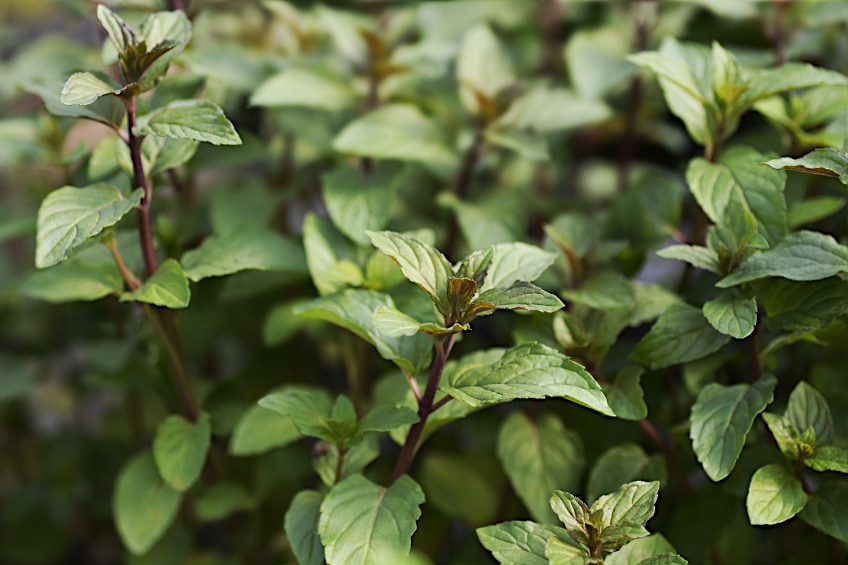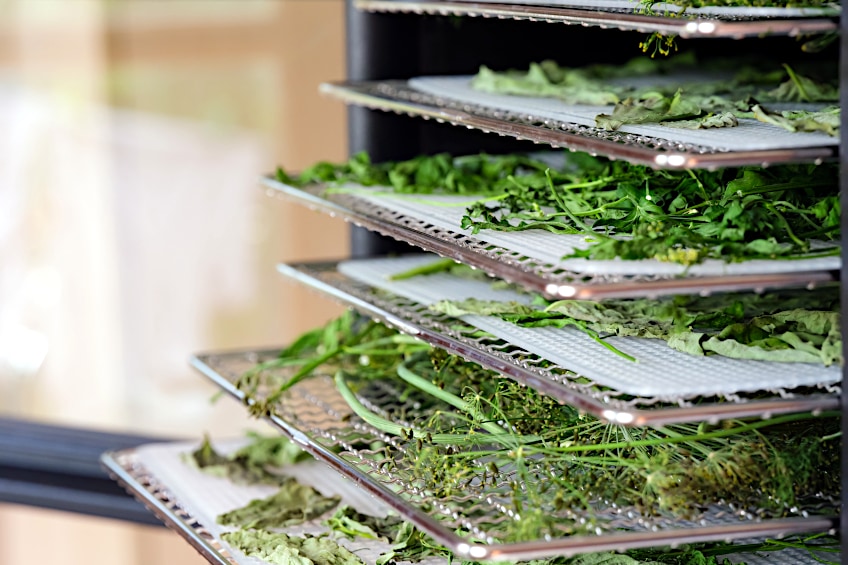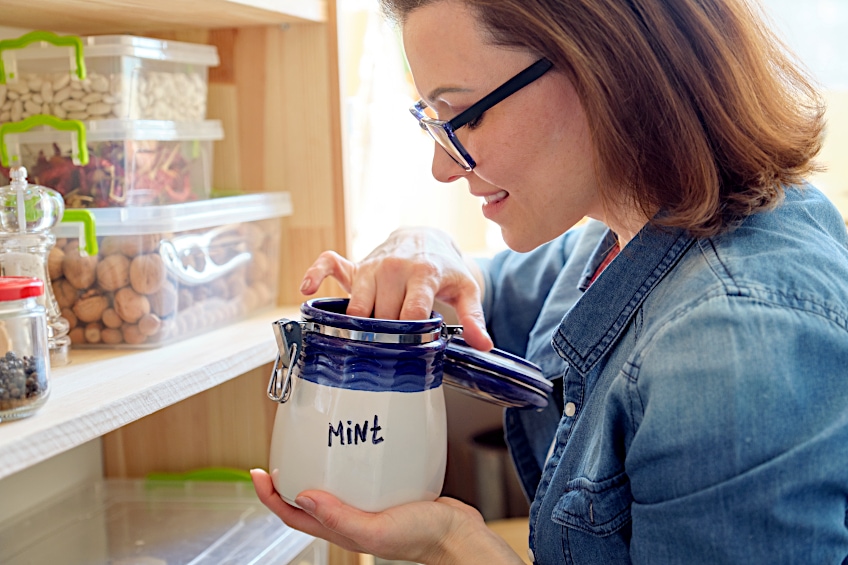Everyone knows how refreshing a glass of water with a few leaves of fresh mint can be, but can you dry mint leaves too? Drying peppermint or other mints is a great way of preserving your leaves for later. Today we will discuss how to dry mint for tea and other potential uses. We will explore how to dry mint in the oven, in the open air, as well as in a dehydrator.
What Is Mint?
The mint plant is an aromatic evergreen herb with serrated leaves and small pink, purple, or white blooms. Mint comes in many different types, all of which are pleasant, whether smooth or furry, straight or creased, brilliant green or multicolored. Nevertheless, a mint may always be identified by its square stalk. When you rub it with your fingers, you’ll notice a strong aroma that reminds you of delicious teas, candies, or even mixed drinks.

Mint plants are often used as accents in gardens, ground covers, herbal treatments, as well as cooking ingredients. Mint plants are as gorgeous as they are useful, and they’re also not hard to grow, flourishing in both the shade and sunlight all across North America. Because mint may spread quickly, you must be mindful of where you grow it.

The Types of Mint You Can Use for Drying
Mint species are among the most regularly planted species in North American gardens, and it’s simple to understand why. Mints are used as flavoring herbs in both meals and drinks. Let’s look at some of the mint varieties that you can grow and dry for tea.

Peppermint
Pink blossoms and spherical leaves characterize peppermint. The leaf is dark green and serrated around the edges. This plant is commonly used to flavor teas, but it is also useful in potpourri, as is most mint.
When swallowed, the fragrance of peppermint is pleasant and can help relieve stomach discomfort.

Chocolate Mint
Chocolate mint, a peppermint cousin, is an oddity: The “chocolate” in its name refers to its fragrance rather than its flavor, as it has an orange-like flavor. It is used to flavor beverages as well as sweets. If you’re looking for something visually appealing, this plant has deeper green leaves than most other forms of mint, as well as lavender-colored blooms.

Spearmint
While the colloquial name refers to the form of the leaves, the scientific name might apply to either the foliage or the blooms, which grow on pointed spikes. The blooms range in color from pink to light violet. Spearmint is a common flavoring ingredient for bubble gum, as well as in salads and drinks.
Some gardeners choose the variety Kentucky Colonel above others since they believe it has better foliage.

Watermint
Watermint features lavender blooms and deep green leaves with purple veining. But what distinguishes this mint from the rest is that it can be planted in shallow water. Gather the foliage to be used as a balm or for other purposes such as adding to salads and tea infusions.

Applemint
Apple mint’s leaves are typically paler green than those of other mints. Its blooms are colored white or pale pink. The leaves might be oblong or oval in shape. Its common name stems from its scent and taste, which are both minty and fruity, and it is perfect for flavoring tea.

Pineapple Mint
Pineapple mint is an apple mint variant. It is prized for its multicolored foliage. Because of the magnificence of its leaves, it is more prone to be cultivated solely as a decorative than the other plants on this list, yet may still be used in the kitchen. Pineapple mint can be used to add flavor to fruit salads, jellies, and drinks.
Given the beautiful leaves, it may also be your best pick if you’re searching for a mint to utilize as a garnish.
The Health Benefits of Mint Tea
Mints are a common fragrant plant noted for their refreshing taste and health benefits. People have used many varieties of mints all throughout the world since before recorded history. A large variety of mint plants has several health advantages. Mints include phytonutrients and antioxidants, as well as vitamin C, vitamin A, and B-complex, calcium, phosphorus, and anti-bacterial qualities. It is high in potassium, iron, and manganese, which boosts blood levels and helps brain activity.
Mint is low in calories and has low-fat content, so you may easily incorporate it into your weight reduction diet plan.

Treating Indigestion
Mint leaves are well-known as an excellent appetizer as it aids the digestive system by activating digestive enzymes. Mint oil contains antibacterial and antiseptic characteristics that can help with stomach infections, indigestion, and other ailments. Due to the levels of methanol, it also functions as an anti-spasmodic medication.

Relief From Irritable Bowel Syndrome (IBS)
IBS is a common digestive system illness. It can potentially create stomach discomfort, diarrhea, constipation, and indigestion. Changing one’s eating habits is the most reliable cure for IBS, however, some trials have suggested that the oil of mint can be very beneficial.
Mint oil includes the chemical menthol, which relaxes the digestive tract.

Treating Respiratory Issues
Mint is often suggested for asthma sufferers because they help the muscles relax and also assists in reducing chest congestion. Daily use of mint leaves might provide relief to asthmatic people. It is believed that mint can also assist with blocked noses, and menthol can help with breathing. It can also help soothe the discomfort produced by a persistent cough.

Improving Oral Hygiene
Because of its germicidal capabilities, mint leaves may rapidly refresh your breath. The extract from the leaves of the mint plant can also assist in plaque removal from the teeth. Menthol toothpaste helps stop oral bacterial development and keeps your mouth feeling and smelling fresh and clean.

Improves Brain Function and Mood
Mint leaves are a great brain tonic. Research suggests that ingesting mint may improve alertness and cognitive functioning. Mint is an important tool in aromatherapy. Its powerful and invigorating aroma may help relieve one’s stress and assist in revitalizing the mind. Your mind is soon soothed by inhaling the scent of mint.
For quick tension and anxiety relief, add some dried mint leaves to your tea.

Mint and Your Skin
Mint is an old remedy used to cure skin disorders such as acne and scars. Mint is believed to have noteworthy antibacterial and anti-inflammatory attributes that can assist in clearing up acne and reducing the inflammation and irritation linked with pimple breakouts. Mint leaves are high in vitamin A and salicylic acid, which reduce sebum oil release in the skin and aid in spot treatment. Mint leaf extract can be used daily to prevent and treat acne.
Mint leaves’ menthol content makes them an excellent cleanser, toner, and emollient for the skin. Mint leaves also tone the skin and ease dry, irritated skin.

Mint and Your Hair
Mint leaf extract is high in carotene, which stimulates hair development and minimizes hair loss. Mint leaves’ antibacterial characteristics are used to treat head lice and dandruff, among other things. Apply the mint along with some lemon to the scalp and leave it for around 35 minutes before rinsing thoroughly.

Alleviation of Allergies and Asthma
Recent research has shown that mint has more than 50 different anti-allergic chemicals. This implies that consuming mint can help alleviate many forms of allergies to some extent. A rat clinical trial found that mint is more efficient than the drug dexamethasone in relieving symptoms in asthmatics.
According to this research, mint may have comparable effects on people.

Potential Side Effects to Be Aware Of
Mint leaves are typically safe to consume. However, patients with reflux issues should limit their intake since it may cause gastrointestinal discomfort. Menthol oil should not be used topically on youngsters since it might cause respiratory problems.
Planting Your Own Mint for Tea
Mints are strong perennials that flourish in light, well-drained soil. They tend to thrive in a slightly damp yet well-drained area, similar to streambeds where they would usually be found wild in nature. Most varieties of mint will do well in sun as well as shade; multicolored varieties may prefer some shade to direct sun.
Plant a couple of plants in damp soil approximately 2 feet apart for outdoor cultivation. Just a couple of plants are enough to cover the ground.

Growing Your Mint Plants
Mint is a robust plant that must be watched as it can very quickly give out runners and proliferate all over your yard. Grow mint in its own garden bed or designated section to avoid it becoming ground cover as it may become problematic. Plant mint near tomatoes and cabbages in the garden to keep it from proliferating and taking nutrients from your other plants. Mint requires little attention, so add a little mulch around outside plants.
This will help to keep the soil moist and the leaves clean.

Water indoor plants on a regular basis to keep the ground uniformly wet. Mints begin as well-behaved, thick, erect clusters, but they quickly set out to explore new ground with runners and subsurface rhizomes. A little peppermint plant may grow into a towering 4-foot behemoth in just one year unless you stop it. Don’t forget that pruning and picking are beneficial to mints.
They are shallow-rooted and simple to take out, so you do not need to worry as long as physical obstacles such as walls are present.

Harvesting Your Mint for Drying
The secret to maintaining mint plants at their prime is frequent picking. Younger mint leaves have a bolder taste than older mint leaves, and mint may be gathered as soon as it sprouts in the springtime. Trim the stalks one inch from the base just before flowering. One mint plant can be harvested several times throughout the season. You may also simply select the leaves as needed. You may grow the plant indoors to have fresh mint leaves throughout winter.
It’s preferable to clip the leaves immediately before flowering if you wish to dry them.
How to Dry Mint Leaves Properly
Nothing beats a hot mug of mint tea after a hard, chilly day! Even though it has no caffeine, mint tea is pleasant and can also help you get ready for the day in the mornings. Mint is also an excellent plant for cooking and medicinal purposes.

How to Dry Mint for Tea
The purpose of drying mint is to eliminate moisture from the plant while retaining nutrients. The antioxidants, taste, and scent are all retained. The idea is not only to keep them from going to waste; but also, to save the nutrients and aroma of the raw plant and, ideally, concentrate it. Before you begin drying your mint, properly rinse it; you don’t want mint with dirt on it.
Pat the mint dry before continuing with your preferred method.

How to Dry Mint in the Oven
If you don’t have enough room or are in a hurry, you may dry the mint in the oven. This technique will save you a significant amount of time because your mint will be prepared in hours, not days or weeks. After washing and drying the leaves, separate them from the stems and arrange them on lined baking sheets, leaving enough room between them for airflow to circulate.

Put the trays in the oven at the lowest setting, preferably less than 203 degrees Fahrenheit (95 degrees Celsius), since higher temperatures might cause the herb to brown and burn. This process will require a varying length of time, based on the temperature. To vent steam and dry the herbs faster while avoiding scorching, hold the oven window partially open with a heat-resistant wooden spoon. After an hour, turn the mint leaves over to promote quicker and more consistent drying.
How to Air-Dry Mint for Tea
After cleaning and rinsing the fresh mint, arrange it in a bundle and bind it together with string at the stems. Hang the bundle somewhere warm and well-ventilated, far from direct sunshine. You may do this by making a drying device out of string, curing the mint with a hanger, or even utilizing a drying rack for herbs. If you reside in a dry, warm area, use this technique to keep your mint leaves from growing moldy. Also, keep them away from direct sunshine to avoid browning the leaves and destroying the minty oils. Leave it all to air dry for a few days up to a week, or until it is dried and ‘crunchy’ to the touch. Because of the extended drying time, it’s a great idea to wrap the herbs with a perforated outer layer, such as a paper bag, to keep dust from accumulating on the mint.

How to Dry Mint Leaves in a Dehydrator
Strip the leaves from the stalks after they have been cleaned and dried. Spread the foliage in a uniform thickness across your dehydrator trays, leaving room for air to circulate between them. Dry the herb for about three hours at 104° Fahrenheit (40° Celsius) until it is brittle and crumbles to bits rather than bending. The time may vary depending on your unit, how much you’re drying, where you reside, and so on. It is recommended to take a peek at them after around 2 hours and then again afterward every 15 to 20 minutes.
Leave the dried mint to cool completely before placing them in a container.

Storing the Dried Mint
After drying your mint, just gather the mint in a jar or other sealed vessel of your choosing. Glass containers are many people’s preference; they will also look beautiful in your home. When preserving the dried mint, you can preserve them whole or crush them. Some people prefer to keep their mint intact and crush them only before preparing them.
It helps to maintain the scent, and the dried mint will stay fresh for at least a year, allowing you to make it every season and enjoy dried mint all year round.
Using Your Dried Mint in Tea
To create mint tea, add a tablespoon of dried and crushed mint leaves to a tea strainer for each mug of boiling water. Put some honey in it if you would like to make it even more wonderful. In terms of cuisine, dried mint may be used in a variety of recipes that include lentils, meat, beans, or rice. Many adore adding mint leaves to their soups because it adds a unique flavor.

Mint Tea
Fresh mint leaves lend an enticing herbal scent and flavor to this mint tea recipe. This tea is classified as a herbal tea or tisane since it is prepared with a herb rather than tea leaves and has no caffeine. You may have a cup of mint tea before going to bed without worrying about it keeping you awake.
Peppermint and spearmint are traditional options, although other types will suffice. You can even use a combination of several mints.
While dried mint may be used to make tea, it lacks the taste of fresh herbs. It can be served chilled or hot, with or without lemon and honey. If you enjoy mint tea but desire a caffeinated drink, Moroccan mint tea produced from a combination of green tea and mint leaves may be precisely what you’re looking for. Choose an iced tea preparation for a refreshing summer drink.

Ingredients
- Two cups of water
- Around 10 or more mint leaves
- A couple of teaspoons of honey
- A cup of ice
- Some lemon juice
Simply bring your water to a boil and then remove it from the stove. Then add your leaves and allow them to steep for approximately five minutes. Lastly, you can add some optional honey and lemon to your preferred tastes. If you prefer to make some iced tea, simply take a few tall glasses and add some ice, then pour the tea over the ice and allow it to chill.
That wraps up our suggestions on how to cultivate, harvest, and dry mint leaves. Learning to dry mint in the oven, in a dehydrator, or even air-drying is not really that difficult at all. Additionally, the techniques you have learned can also be applied to other herbs too! Whether you are drying peppermint, spearmint, or one of the many other variations of mint, this guide on how to dry mint for tea offers you everything you need to know to create the perfect dried mint leaf mixture!
Frequently Asked Questions
Can You Dry Mint Leaves?
Yes, absolutely you can dry mint leaves for later use. While it is nice to walk into your garden and pick a few fresh leaves for your morning cup, it is not always practical or possible. Therefore, learning how to dry mint leaves is a very helpful skill to acquire as you will be able to make and store your own mint leaves whenever and wherever you choose!
How Do I Dry Mint Leaves?
Once you have harvested your leaves for drying, there are three ways that you could do so. You can either dry mint in the oven, or you can air dry your mint, or last of all, you can allow them to dry in a dehydrator. Each method takes a different amount of time to dry the leaves, so choose one based on your personal needs. If you are in a major rush, then obviously the quicker method would be the one that provides the most heat: the oven. However, due to the quick drying time and intense heat, it is a good idea to check up on the progress of the mint leaves regularly to avoid burning them to a crisp.
What Are the Benefits of Drinking Mint Tea?
Mint oil has antibacterial and antiseptic properties that can aid in the treatment of stomach infections, indigestion, and other disorders. It can relieve stomach pain, bloating, diarrhea, and constipation because it relaxes muscles and relieves chest congestion. Asthmatics may benefit from the usage of mint leaves on a daily basis. Mint is an ancient treatment used to treat skin conditions such as acne and scarring.
The post How to Dry Mint Leaves – Cultivating Mint Plants for Tea appeared first on Natural Herbal Living.




